Moviedom's 15 Best Comic Book Movies...and the 9 Worst, Part III
Although the comic-book movie genre has been among the most popular over the course of the last 10 to 15 years, it was around for a couple of dozen before that. In recent years, the introduction of computer-generated imagery into cinema has caused an explosion of films based on comics, finally freeing filmmakers to cut loose on properties based on fanboys' favorite funnybooks.
Sometimes this strategy has worked wonders, creating crowd-pleasing classics, action-packed spectacles and character-driven masterpieces.
It has also spawned a series of cinematic turds — unmemorable or aggressively bad films that botch good characters or focus on the wrong ones while applying outdated filmmaking techniques or narrative devices.
Here, then, are the best and worst of the lot, broken into three parts:
5. "X2: X-Men United" (2003)
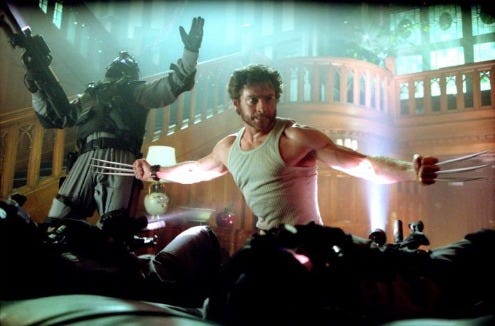
The first "X-Men" film was in many ways considered an experiment: It was the first of the big-name Marvel titles to get a film treatment and its success or failure would show Hollywood how viable Marvel comics would translate to the big screen. Of course, the film was a runaway hit, but the film was bogged down with a series of origin stories of the main characters, which again encapsulates why many comic book sequels are better than the original. Hence, "X2: X-Men United."
We know our characters, we know their plights and we can move on to the meaty stuff, which we do quickly by way of a spectacular opening scene with Nightcrawler (Alan Cumming) making a play to assassinate the President of the United States.
Everything about the sequel is grander, from Wolverine (Hugh Jackman) getting closer to discovering his roots to the relationship between Xavier (Patrick Stewart) and Magneto (Ian McKellan) to the uneasy alliance their teams form to stave off a government agent (Brian Cox) who has his own shameful relationship to the mutants.
Again, Wolverine gets beaten down by a woman, in a sequence that's faster, more vicious and better than his already-good fight with Mystique (Rebecca Romijn) from the first film. Kelly Hu's Deathstrike doesn't have the relationship with Logan that she did in the comics, but it's a fantastic sequence nonetheless.
Characters are killed off, and the film's final shot gives glimpses of a third film that had the fanboy community wetting its collective pants. Alas, the third film, "X-Men: The Last Stand," did not deliver on that promise, but hey, we'll always have Alkali Lake.
4. "Spider-Man 2" (2004)
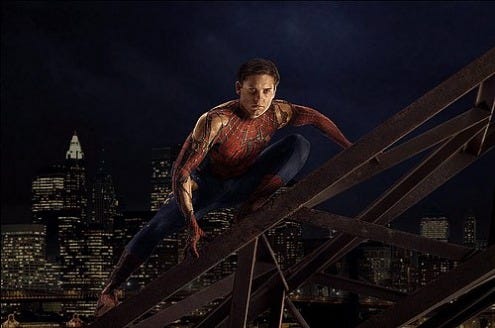
The first "Spider-Man" was a gigantic hit, but again was mired in origin-story hell. While it was, in a sense, watershed in its use of CG animation for our hero, the technology wasn't up to snuff — at least when compared to the marvel of "Spider-Man 2," which featured more action, more web slinging and, quite frankly, a better villain.
"Spidey 2" dug into the soul of Peter Parker and his gift and curse of having the proportionate speed and strength of a spider (along with, you know, the organic web shooters). He swings with the greatest of ease high above the streets of New York, but can't pay his rent on time, can't keep his grades up and can't even make the 8 p.m. curtain of his true love's hit Broadway play.
He can't even keep a couple of friends, alienating seemingly everyone until, fed up, he gives up being Spider-Man altogether. Then an accident turns the affable, kindly Dr. Octavius (Alfred Molina) into the evil Doctor Octopus, and things change when Doc Ock starts getting personal with Peter.
The fight scenes are breathless and spectacular, the emotion is real and the characters (well, mostly) are believable. Admittedly, the years haven't been as kind as they could be, and some of the stink of "Spider-Man 3's" ham-fisted cramming of characters, silly plot developments and tired storytelling techniques originated in "Spidey 2." But this sequel remains, to date, the definitive vision of Spider-Man and is still a thrilling ride.
3. "Iron Man" (2008)
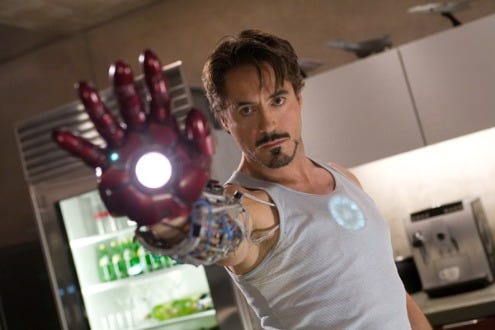
How do you do yet another origin story — where a great deal of the movie sees a superhero toiling away in a lab while building, testing, re-testing and testing his weaponry again — and still have a great superhero movie? Well, ask Jon Favreau. He's the one who did it.
Step one was casting Robert Downey Jr., he of his own substance-abuse demons, as millionaire playboy/borderline alcoholic weapons developer Tony Stark, who, after being abducted by Middle Eastern terrorists, is forced to make a missile that will give them an advantage against the U.S. Instead, Stark builds a supersuit that allows him to escape — an experience that forces him to re-examine his life and leads to the birth of Iron Man.
It is Downey's runaway charisma that makes the film work, even as he sits alone in his workshop tinkering with the pieces — failing and revising his work, often comically, until the thrilling rush that comes when he makes a successful flight, then runs missions.
If the film has a downfall, it's the slow-motion 'bot-on-'bot violence of the film's finale. Stark fights his mentor, who has stolen Tony's tech and the device that keeps him alive (which powers the suit) to make his own suit, which he intends to weaponize and sell. It's not as exhilarating as the rest of the film, but the groundwork is there, leading "Iron Man" into the elite tier of superhero films.
2. "American Splendor" (2003)
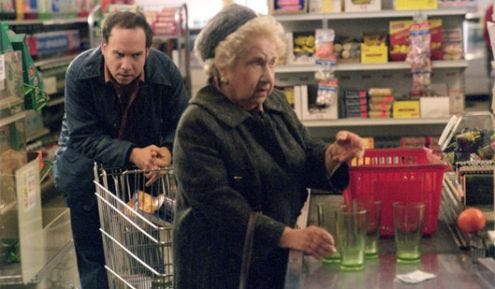
An experimental trip into the alternately surreal and mundane qualities of Harvey Pekar's life, "American Splendor" is an odd film that doesn't know whether it's documentary, based on a true story or based on a comic book that might have some semblance to reality. Either way, it at least knows it's that, and the result is a beautiful story about an ugly man — a Cleveland file clerk who, at the behest of famed comic artist Robert Crumb, starts a comic book about his dreary existence.
Paul Giamatti ("Sideways") plays Pekar — well, except for the times the real-life Pekar interrupts the film to interject some of his wisdom into the proceedings. Giamatti's Pekar is a man worn down by his own cragginess, and even his one passion, his comic book, is little more than a gigantic pain in the ass.
Things look up for him when a fan of his book, Joyce Brabner (Hope Davis), comes into his life. Soon they're living together, leading to an entirely different set of problems that come about when two people live together for an extended period of time.
Giamatti gives a fantastic performance, as does Judah Friedlander ("30 Rock") as Harvey's nerdy friend.
"Splendor" is a whimsical, smart, touching look at life and all of its facets, and Pekar's angst is our pleasure.
1. "The Dark Knight" (2008)
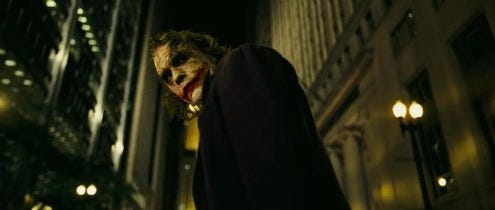
Not so much a superhero movie as a crime drama with a cape, "The Dark Knight" launches leagues beyond fanboy expectations of a superhero film. Instead, director Christopher Nolan blindsided us all with a hard-hitting, labyrinthine film about the nature of crime, heroism and society.
And yes, Heath Ledger's Joker was one of the definitive performances of the 2000s, one of the greatest villains of all time, and surpasses what Jack Nicholson did with the character onscreen in 1989. His Joker is concerned with nothing, including his own life, aside from introducing chaos into the world.
But this film is about Bruce Wayne (Christian Bale), who finally with this series is the focus of the movie, and Bale is spectacular — gravel-voiced Batman haters be damned. It is his own actions that cause the freaks to come out of the woodwork; as Lt. Gordon (Gary Oldman) notes at the end of "Batman Begins," "You buy Kevlar, they buy armor-piercing rounds ... and now you're running around in a cape and mask." "Knight" is the embodiment of that theory ... and how the Joker raises the stakes by remaining two steps ahead of not just Batman, but the police, the media, everyone.
Much of "Knight" is about choices: When one will die, who to rescue? District Attorney Harvey Dent (Aaron Eckhart), the city's "White Knight" who may supplant Batman as the city's savior, or Bruce's love, Rachel Dawes (Maggie Gyllenhaal)? When two boats are wired to explode — one full of convicts, one of "ordinary" citizens, with each boat possessing the other's detonator — which blows? Its taut, riveting action sequences are a whirlwind of uncertainty. What is the Joker going to do next? How can Batman and the police stop him?
"Knight" is indeed dark, killing off a major character, turning another from hero to villain and raising the bar for the superhero genre so high that perhaps no one short of Nolan himself can hope to meet it. "Knight" is a film where anything can happen, and given the tone of the film, you'd believe that it just might.
Worst:
3. "Fantastic Four" (1994)
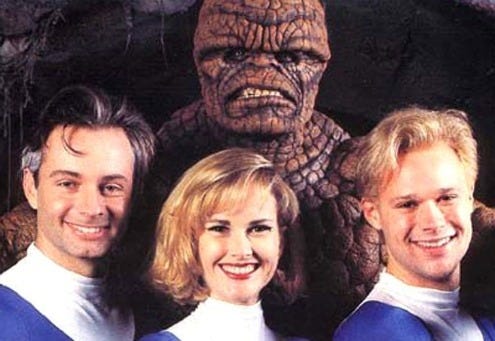
A movie so bad even Roger Corman wouldn't release it. In all fairness, this film was never actually released or meant to see the light of day, and exists only in bootleg form. It was made simply because the rights-holders were about to lose the rights to the property if they didn't make a film before a certain date, so they hastily cobbled together this movie with as low a budget as possible, then shelved it.
2. "Captain America" (1990)
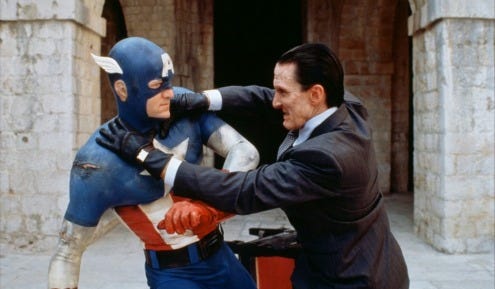
1989's "Batman" was thought to have been the start of a new wave of superhero flicks, and a couple of them immediately followed, neither with particular success. First was 1989's "The Punisher," starring Dolph Lundgren (and later remade with Thomas Jane in the title role). The other came in 1991, with "Captain America."
The unknown Matt Salinger, son of famous "Catcher in the Rye" author J. D., was cast as Steve Rogers, the boy too sickly and skinny to be a soldier who is given the chance to become a super-soldier thanks to a special serum, then placed in a gawdy rubber suit and given a plastic-looking shield.
In this film, a Nazi doctor invented the serum and created the evil Red Skull out of an Italian boy. Skull's battle with Cap leaves the Star-Spangled Avenger frozen in suspended animation for 50 years until he awakens in the 1990s. He then proceeds to spend about half of the film out of the Captain America costume, rediscovering who he is.
But wait! The boy Cap rescued back in '43 is now President of the United States, and Skull — who through surgery now isn't so red and icky — is plotting to kidnap him.
Salinger looks lost as Captain America, and the suit is utterly ridiculous. There are technical gaffes and holes in logic all over.
It's so bad that scant months before the new blockbuster version hits theaters, it's not even available to buy on DVD. If you gotta see this, hope you still have a VCR or can find a torrent online (not that we recommend such actions).
1. "Batman and Robin" (1997)
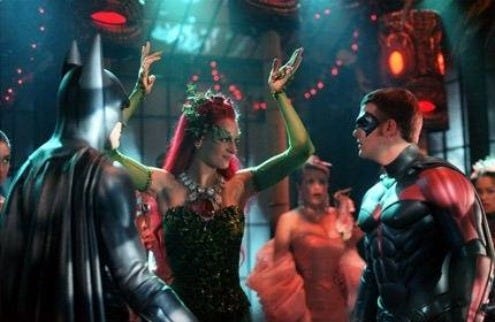
Still the champion of all bad comic-book movies, "Batman and Robin" took all the worst aspects of the mediocre-but-still-servicable "Batman Forever," magnified them and threw them out in a made-for-Toys-R-Us fourth film. Conceptually, look at it like this: The main villains who team up to fight Batman and Robin are Poison Ivy (Uma Thurman), a woman who wants plants to rule the world, and Mr. Freeze, a man who wants to freeze that same world. Seems like their goals are a bit divergent, right?
There's more: hokey humor, Batman and Robin playing a game of combat hockey with Freeze's goons, nipples on the batsuits (though, to be fair, the "Forever" suits also had nipples), a Batman credit card (with an admittedly funny expiration-date gag reading "Forever"), a neon-ensconced Gotham City, horribly choreographed fight scenes, space surfing, an ugly one-seater Batmobile and "Max Headroom" Alfred, among others.
Then, we have crimes against characters: Bane (Jeep Swensson) is one of the most popular characters in the comics, having actually defeated Batman, which leads to one of the great arcs for the Dark Knight. In the film, he's turned into a grunting brute of a lackey for Poison Ivy and relegated to a glorified random thug.
Then we get to Mr. Freeze, one of the great tragic villains of Batman lore with an icy soul and a state of perpetual depression at his plight: He is trying to find a cure for his terminally ill wife, who is in suspended animation. But Arnold Schwarzenegger turns him into a quipping prankster who spouts bad one-liners like they're going out of style.
Batgirl is no longer Barbara Gordon, the Commissioner's daughter, and instead is Barbara Pennyworth, Alfred's long-lost niece. It's a ridiculous, pointless and nonsensical change. (The British Alfred has a Valley Girl niece? Seriously?)
Everything about the film is rushed and done in such a scattershot, random manner that there's no time to let anything sink in. No, we need more characters! More costumes! More explosions! At least Warner Bros. had plenty of material with which to stock toy-store shelves.
The result left DC's Batman franchise dead in the water right on the eve of Marvel's explosion (the first "Blade" film came out the following year, which led to "X-Men," which led to "Spider-Man" and the game was on), and it didn't recover for almost a decade. This film's failure left a gaping hole in DC Comics film adaptations that they're just now starting to catch up on with this year's "Green Lantern" film.


